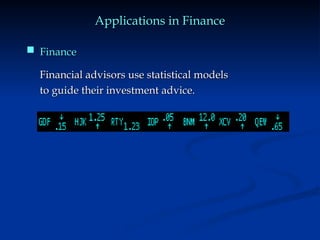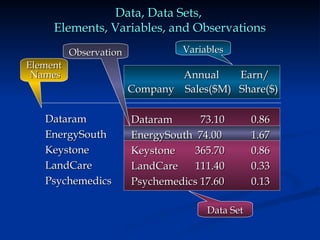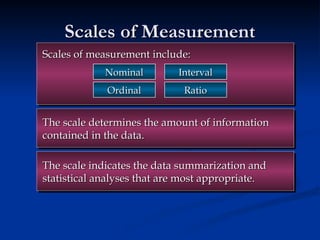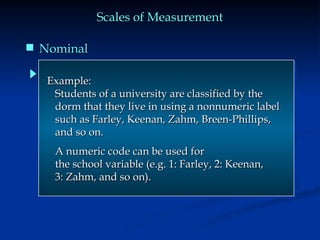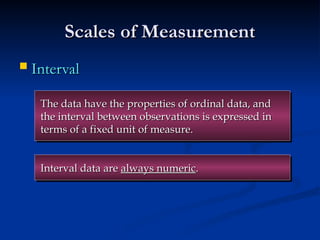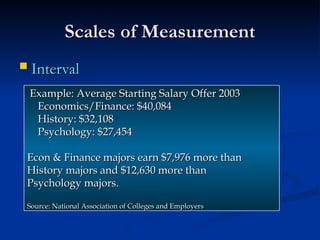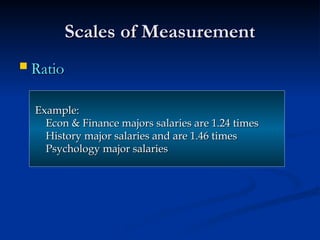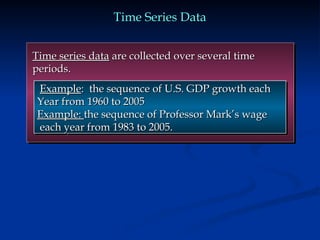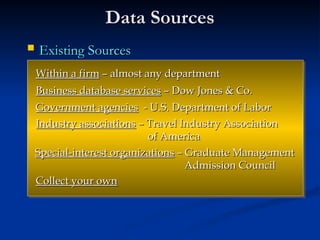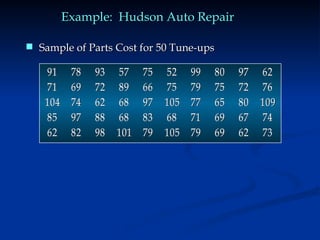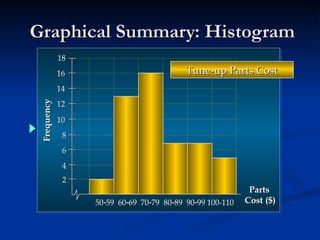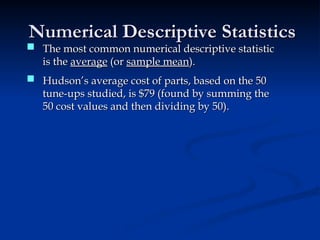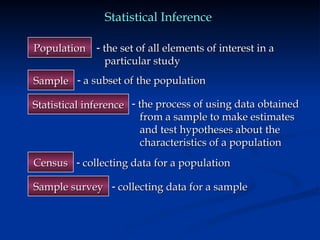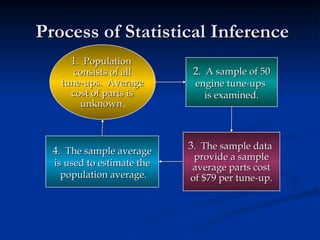Statistics for business and economics Measurement scales.ppt
- 2. Chapter 1 Chapter 1 Data and Statistics Data and Statistics I need I need help! help! Applications in Economics Data Data Sources Descriptive Statistics Statistical Inference Computers and Statistical Analysis
- 3. Applications in Economics Applications in Economics Statistics Statistics: a methodology to use data to : a methodology to use data to learn the “truth.” i.e., Uncover the true learn the “truth.” i.e., Uncover the true data mechanism data mechanism Probability Probability: Branch of mathematics that : Branch of mathematics that models of the truth models of the truth In economics, we estimate and test economic models In economics, we estimate and test economic models and their predictions and their predictions Use empirical models for prediction, Use empirical models for prediction, forecasting, and policy analysis. forecasting, and policy analysis.
- 4. Applications in Business Applications in Business Statistical quality Statistical quality control charts are used to monitor control charts are used to monitor the output of a production process. the output of a production process. Production Production Electronic point-of-sale scanners at Electronic point-of-sale scanners at retail checkout counters are used to retail checkout counters are used to collect data for a variety of marketing collect data for a variety of marketing research applications. research applications. Marketing Marketing
- 5. Applications in Finance Applications in Finance Financial advisors use statistical models Financial advisors use statistical models to guide their investment advice. to guide their investment advice. Finance Finance
- 6. Annual Earn/ Annual Earn/ Company Sales($M) Share($) Company Sales($M) Share($) Data, Data Sets, Data, Data Sets, Elements, Variables, and Observations Elements, Variables, and Observations Dataram Dataram 73.10 73.10 0.86 0.86 EnergySouth 74.00 EnergySouth 74.00 1.67 1.67 Keystone Keystone 365.70 365.70 0.86 0.86 LandCare LandCare 111.40 111.40 0.33 0.33 Psychemedics 17.60 Psychemedics 17.60 0.13 0.13 Variables Variables Data Set Data Set Observation Observation Element Element Names Names Dataram Dataram EnergySouth EnergySouth Keystone Keystone LandCare LandCare Psychemedics Psychemedics
- 7. Data and Data Sets Data and Data Sets Data Data are the facts and figures collected, are the facts and figures collected, summarized, analyzed, and interpreted. summarized, analyzed, and interpreted. The data collected in a particular study are referred The data collected in a particular study are referred to as the to as the data set data set. .
- 8. The The elements elements are the entities on which data are are the entities on which data are collected. collected. A A variable variable is a characteristic of interest for the elements. is a characteristic of interest for the elements. The set of measurements collected for a particular The set of measurements collected for a particular element is called an element is called an observation observation. . The total number of data values in a data set is the The total number of data values in a data set is the number of elements multiplied by the number of number of elements multiplied by the number of variables. variables. Elements, Variables, and Observations Elements, Variables, and Observations
- 9. Scales of Measurement Scales of Measurement Qualitative Qualitative Quantitative Quantitative Numerical Numerical Numerical Numerical Nonnumerical Nonnumerical Data Data Nominal Nominal Ordinal Ordinal Nominal Nominal Ordinal Ordinal Interval Interval Ratio Ratio
- 10. Scales of Measurement Scales of Measurement The scale indicates the data summarization and The scale indicates the data summarization and statistical analyses that are most appropriate. statistical analyses that are most appropriate. The scale determines the amount of information The scale determines the amount of information contained in the data. contained in the data. Scales of measurement include: Scales of measurement include: Nominal Nominal Ordinal Ordinal Interval Interval Ratio Ratio
- 11. Scales of Measurement Scales of Measurement Nominal Nominal A A nonnumeric label nonnumeric label or or numeric code numeric code may be used. may be used. Data are Data are labels or names labels or names used to identify an used to identify an attribute of the element. attribute of the element.
- 12. Example: Example: Students of a university are classified by the Students of a university are classified by the dorm that they live in using a nonnumeric label dorm that they live in using a nonnumeric label such as Farley, Keenan, Zahm, Breen-Phillips, such as Farley, Keenan, Zahm, Breen-Phillips, and so on. and so on. A numeric code can be used for A numeric code can be used for the school variable (e.g. 1: Farley, 2: Keenan, the school variable (e.g. 1: Farley, 2: Keenan, 3: Zahm, and so on). 3: Zahm, and so on). Scales of Measurement Scales of Measurement Nominal Nominal
- 13. Scales of Measurement Scales of Measurement Ordinal Ordinal A A nonnumeric label nonnumeric label or or numeric code numeric code may be used. may be used. The data have the properties of nominal data and The data have the properties of nominal data and the the order or rank of the data is meaningful order or rank of the data is meaningful. .
- 14. Scales of Measurement Scales of Measurement Ordinal Ordinal Example: Example: Students of a university are classified by their Students of a university are classified by their class standing using a nonnumeric label such as class standing using a nonnumeric label such as Freshman, Sophomore, Junior, or Senior. Freshman, Sophomore, Junior, or Senior. A numeric code can be used for A numeric code can be used for the class standing variable (e.g. 1 denotes the class standing variable (e.g. 1 denotes Freshman, 2 denotes Sophomore, and so on). Freshman, 2 denotes Sophomore, and so on).
- 15. Scales of Measurement Scales of Measurement Interval Interval Interval data are Interval data are always numeric always numeric. . The data have the properties of ordinal data, and The data have the properties of ordinal data, and the interval between observations is expressed in the interval between observations is expressed in terms of a fixed unit of measure. terms of a fixed unit of measure.
- 16. Scales of Measurement Scales of Measurement Interval Interval Example: Average Starting Salary Offer 2003 Example: Average Starting Salary Offer 2003 Economics/Finance: $40,084 Economics/Finance: $40,084 History: $32,108 History: $32,108 Psychology: $27,454 Psychology: $27,454 Econ & Finance majors earn $7,976 more than Econ & Finance majors earn $7,976 more than History majors and $12,630 more than History majors and $12,630 more than Psychology majors. Psychology majors. Source: National Association of Colleges and Employers Source: National Association of Colleges and Employers
- 17. Scales of Measurement Scales of Measurement Ratio Ratio The data have all the properties of interval data The data have all the properties of interval data and the and the ratio of two values is meaningful ratio of two values is meaningful. . Variables such as distance, height, weight, and time Variables such as distance, height, weight, and time use the ratio scale. use the ratio scale. This This scale must contain a zero value scale must contain a zero value that indicates that indicates that nothing exists for the variable at the zero point. that nothing exists for the variable at the zero point.
- 18. Scales of Measurement Scales of Measurement Ratio Ratio Example: Example: Econ & Finance majors salaries are 1.24 times Econ & Finance majors salaries are 1.24 times History major salaries and are 1.46 times History major salaries and are 1.46 times Psychology major salaries Psychology major salaries
- 19. Data can be qualitative or quantitative. Data can be qualitative or quantitative. The appropriate statistical analysis depends The appropriate statistical analysis depends on whether the data for the variable are qualitative on whether the data for the variable are qualitative or quantitative. or quantitative. There are more options for statistical There are more options for statistical analysis when the data are quantitative. analysis when the data are quantitative. Qualitative and Quantitative Data Qualitative and Quantitative Data
- 20. Qualitative Data Qualitative Data Labels or names Labels or names used to identify an attribute of each used to identify an attribute of each element. E.g., Black or white, male or female. element. E.g., Black or white, male or female. Referred to as Referred to as categorical data categorical data Use either the nominal or ordinal scale of Use either the nominal or ordinal scale of measurement measurement Can be either numeric or nonnumeric Can be either numeric or nonnumeric Appropriate statistical analyses are rather limited Appropriate statistical analyses are rather limited
- 21. Quantitative Data Quantitative Data Quantitative data indicate Quantitative data indicate how many or how much: how many or how much: D Discrete iscrete, if measuring how many. E.g., number , if measuring how many. E.g., number of 6-packs consumed at tail-gate party of 6-packs consumed at tail-gate party Continuous Continuous, if measuring how much. E.g., pounds , if measuring how much. E.g., pounds of hamburger consumed at tail-gate party of hamburger consumed at tail-gate party Quantitative data are Quantitative data are always numeric always numeric. . Ordinary arithmetic operations are meaningful for Ordinary arithmetic operations are meaningful for quantitative data. quantitative data.
- 22. Cross-Sectional Data Cross-Sectional Data Cross-sectional data Cross-sectional data observations across individuals observations across individuals at the same point in time. at the same point in time. Example Example: the growth rate from 1960 to 2004 of : the growth rate from 1960 to 2004 of each country in the world (about 182 of them). each country in the world (about 182 of them). Example Example: wages for head of household in : wages for head of household in Indiana Indiana
- 23. Time Series Data Time Series Data Time series data Time series data are collected over several time are collected over several time periods. periods. Example Example: the sequence of U.S. GDP growth each : the sequence of U.S. GDP growth each Year from 1960 to 2005 Year from 1960 to 2005 Example: Example: the sequence of Professor Mark’s wage the sequence of Professor Mark’s wage each year from 1983 to 2005. each year from 1983 to 2005.
- 24. Data Sources Data Sources Existing Sources Existing Sources Within a firm Within a firm – almost any department – almost any department Business database services Business database services – Dow Jones & Co. – Dow Jones & Co. Government agencies Government agencies - U.S. Department of Labor - U.S. Department of Labor Industry associations Industry associations – Travel Industry Association – Travel Industry Association of America of America Special-interest organizations Special-interest organizations – Graduate Management – Graduate Management Admission Council Admission Council Collect your own Collect your own
- 25. Statistical Studies Statistical Studies Data Sources Data Sources In In experimental studies experimental studies variables of interest variables of interest are identified. Then additional factors are are identified. Then additional factors are varied to obtain data that tells us how varied to obtain data that tells us how those factors influence the variables. those factors influence the variables. In In observational observational (nonexperimental) (nonexperimental) studies studies we we cannot control or influence the cannot control or influence the variables of interest. variables of interest. a survey is a a survey is a good example good example
- 26. Descriptive Statistics Descriptive Statistics Descriptive statistics Descriptive statistics are the tabular, graphical, are the tabular, graphical, and numerical methods used to and numerical methods used to summarize summarize data. data.
- 27. Example: Hudson Auto Repair Example: Hudson Auto Repair The manager of Hudson Auto The manager of Hudson Auto would like to understand the cost would like to understand the cost of parts used in the engine of parts used in the engine tune-ups performed in the tune-ups performed in the shop. She examines 50 shop. She examines 50 customer invoices for tune-ups. The costs of parts, customer invoices for tune-ups. The costs of parts, rounded to the nearest dollar, are listed on the next rounded to the nearest dollar, are listed on the next slide. slide.
- 28. 91 78 93 57 75 52 99 80 97 62 71 69 72 89 66 75 79 75 72 76 104 74 62 68 97 105 77 65 80 109 85 97 88 68 83 68 71 69 67 74 62 82 98 101 79 105 79 69 62 73 Example: Hudson Auto Repair Example: Hudson Auto Repair Sample of Parts Cost for 50 Tune-ups Sample of Parts Cost for 50 Tune-ups
- 29. Tabular Summary: Tabular Summary: Frequency and Percent Frequency Frequency and Percent Frequency 50-59 50-59 60-69 60-69 70-79 70-79 80-89 80-89 90-99 90-99 100-109 100-109 2 2 13 13 16 16 7 7 7 7 5 5 50 50 4 4 26 26 32 32 14 14 14 14 10 10 100 100 (2/50)100 (2/50)100 Parts Parts Cost ($) Cost ($) Parts Parts Frequency Frequency Percent Percent Frequency Frequency
- 30. Graphical Summary: Histogram Graphical Summary: Histogram 2 4 6 8 10 12 14 16 18 Parts Cost ($) Frequency 5059 6069 7079 8089 9099 100-110 Tune-up Parts Cost Tune-up Parts Cost
- 31. Numerical Descriptive Statistics Numerical Descriptive Statistics Hudson’s average cost of parts, based on the 50 Hudson’s average cost of parts, based on the 50 tune-ups studied, is $79 (found by summing the tune-ups studied, is $79 (found by summing the 50 cost values and then dividing by 50). 50 cost values and then dividing by 50). The most common numerical descriptive statistic The most common numerical descriptive statistic is the is the average average (or (or sample mean sample mean). ).
- 32. Statistical Inference Statistical Inference Population Population Sample Sample Statistical inference Statistical inference Census Census Sample survey Sample survey the set of all elements of interest in a the set of all elements of interest in a particular study particular study a subset of the population a subset of the population the process of using data obtained the process of using data obtained from a sample to make estimates from a sample to make estimates and test hypotheses about the and test hypotheses about the characteristics of a population characteristics of a population collecting data for a population collecting data for a population collecting data for a sample collecting data for a sample
- 33. Process of Statistical Inference Process of Statistical Inference 1 1. Population . Population consists of all consists of all tune-ups. Average tune-ups. Average cost of parts is cost of parts is unknown unknown. 2 2. A sample of 50 . A sample of 50 engine tune-ups engine tune-ups is examined. is examined. 3 3. The sample data . The sample data provide a sample provide a sample average parts cost average parts cost of $79 per tune-up. of $79 per tune-up. 4 4. The sample average . The sample average is used to estimate the is used to estimate the population average. population average.




